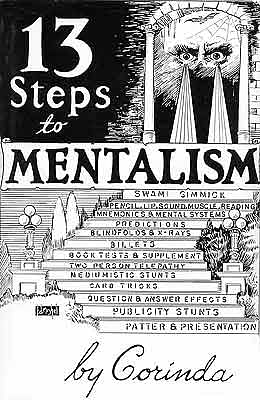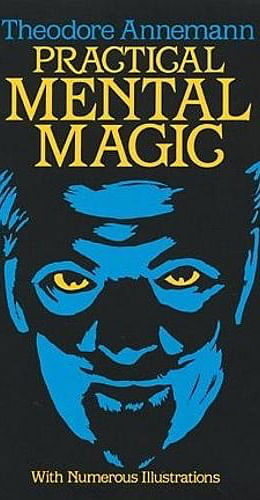How To Get Started In Mentalism
What is mentalism?
Mentalism is, in a nutshell, pretending that you have mental powers.
The actual powers that people demonstrate vary hugely, and we’ll be taking a closer look at the most popular things to pretend you can do later on in this article.
Essentially it boils down to pretending you know what someone is thinking about, pretending you can control what someone is thinking about, or pretending that you knew what someone was going to think about ahead of time.
Why is mentalism so popular?
There’s a few reasons why mentalism has been growing in popularity over the last couple of decades and it really goes back to Uri Geller saying he can bend spoons in the 70s. This catapulted the idea of mentalism to a worldwide audience. Geller was the most famous in the world.
More recently, the UK’s Derren Brown has made his name known very widely through his incredible, award-winning TV and theater shows. Here he is pretending crystals can control Martin Freeman.
And obviously TV shows like The Mentalist have made more mainstream people aware of the art.
Getting started the right way
This article will dive deep into the right way to get started on your journey into mentalism. Buckle up, let’s get going!
Understanding mentalism
The word "mentalism" had its first use in print was in 1909, and it is defined as: of or relating to mental phenomena.
To expand on that a little…
Mentalism is a performing art that creates the illusion of out of the ordinary mental abilities. These may include mind reading, telepathy, and ESP. Mentalists will use a mixture of techniques to give their audience the appearance they have supernatural or paranormal powers.
While some mentalism methods involve a little sleight of hand, such as billet switching (more on that later), the main techniques used are actually more crude and blunt that you may expect. For example if a mentalist reveals a great deal of personal information about a participant, the easiest way to do this is to ask the person this information before the show starts. This is called Pre-Show Work. You can also use social media when people book tickets to find out a great deal of what seems private, impossible to know data. Other techniques such as secretly just looking at a word someone wrote down, or pretending to write a word once, but actually writing it twice, and so on. Most of the actual methods used are very physically simple to do.
What are the key concepts of mentalism?
Mind Reading
The ability to seemingly access and understand thoughts, ideas, or information held within the minds of others without direct communication.
Telepathy
The transmission of information from one person's mind to another's without using the known human senses.
Psychokinesis (PK)
The apparent ability to influence or manipulate physical objects, events, or processes using the power of the mind alone.
Cold Reading
A technique used to gather information about a person through subtle cues, body language, and verbal responses without the subject being aware of the information being obtained.
Suggestion
The use of verbal or non-verbal cues to influence the thoughts, perceptions, or behavior of others, often leading them to accept a certain idea or belief.
Dual Reality
A concept where different individuals experience a performance in different ways, creating the illusion that the mentalist is accomplishing something impossible.
Pre-show Work
Gathering information about audience members or participants before the performance through research, enabling the mentalist to appear more insightful during the act.
Memory Techniques
Employing mnemonic devices and memory aids to demonstrate an exceptional ability to recall details, names, or sequences.
Billet Reading
Reading information sealed in an envelope or hidden from view, creating the impression of accessing private thoughts.
Forcing Techniques
Guiding or influencing a participant to choose a specific option or make a particular decision, giving the appearance of mind control.
What makes mentalism different from magic?
Really it’s the tone. Mentalism is normally performed in a much more serious way than magic. There are exceptions to this, but generally speaking, mentalism is serious.
With magic, you do not pretend you really have magic powers. Your audience suspend disbelief and sit down and enjoy a show. With mentalism you predominantly pretend you have powers. There are exceptions, disclaimers and ethical issues with this, again, something we’ll talk about later on.
Learning the basics
Here is a recommended reading list of books to get you started. Although these books are old, the techniques they teach are still used today by all mentalists.

13 Steps To Mentalism
13 Steps to Mentalism is a classic and comprehensive guide to the art of mentalism, written by Tony Corinda. Originally published in 1961, the book has become a staple resource for aspiring mentalists and magicians interested in mastering the skills and techniques associated with mind reading and psychological illusions. The book is structured into thirteen chapters, each covering a specific aspect of mentalism. Here's a brief synopsis of the key contents:
Swami Gimmick
This chapter introduces the "swami gimmick," a device used by mentalists for secretly writing predictions. The chapter covers techniques for using and concealing the gimmick.
Pencil, Lip, Sound, and Muscle Reading
Chapter two explores methods for seemingly reading thoughts through various means, including observing pencil movements, interpreting lip and sound cues, and understanding muscle reactions.
Predictions
This discusses the art of making predictions and provides insights into different prediction methods, including envelope tricks and prediction presentations.
Blindfold Techniques
Here we focus on techniques for blindfolding and performing feats that give the appearance of heightened sensory perception.
Billets
Exploring the use of billets (small folded pieces of paper) in mentalism, including techniques for obtaining information from participants without their knowledge.
Book Tests
Now we move on to examining methods for conducting book tests, where a mentalist appears to extract information from a chosen book.
Two-Person Telepathy
A wonderful chapter that discusses techniques for creating the illusion of telepathy between two individuals, providing insights into codes and communication methods.
Mediumistic Stunts
This is an exploration of techniques related to mediumistic performances, including table-tipping and spirit communication.
Card Tricks
A controversial chapter examining the use of cards in mentalism, covering effects such as thought reading with cards and other card-related mentalism routines.
Question and Answer Acts
Many say this chapter is worth the price of admission alone. It discusses the structure and performance of question and answer acts, where a mentalist answers questions or provides information seemingly beyond normal knowledge.
Publicity Stunts
Simple methods for gaining publicity and attention as a mentalist, including creative and attention-grabbing stunts.
Patter and Presentation
Now we emphasize the importance of effective storytelling, dialogue, and presentation in mentalism to enhance the overall impact of performances.
The Addenda
Finally we look at additional insights and thoughts on mentalism, including advice on the psychology of performance and the ethical considerations of being a mentalist.
13 Steps to Mentalism is highly regarded for its detailed explanations, practical advice, and the depth of knowledge it offers. It serves as a foundational resource for people wanting to master the art and psychology behind mentalism performances.

Practical Mental Magic
Practical Mental Magic is a classic book written by Theodore Annemann, originally published in 1944. The book is considered a cornerstone in the field of mentalism and has influenced generations of magicians and mentalists.
Here's a synopsis of the key contents:
Mentalism with Cards
Annemann explores methods of achieving mind-reading and prediction effects using playing cards. Techniques include card forces, revelations, and mental feats involving audience participation.
Mentalism with Billets
The use of billets is a central theme. Annemann provides diverse routines involving billets, demonstrating how mentalists can extract information or perform predictions using this simple yet powerful tool.
Book Tests
Annemann delves into the world of book tests, where the mentalist appears to extract information from a chosen book. He outlines different approaches to make this classic effect engaging and deceptive, which is the real key to making mentalism work.
Effects with Slates
The use of slates in mentalism is explored, demonstrating how to achieve effects involving written predictions, spirit writing, and other mysterious slate routines. This chapter may feel horribly dated, but with the right presentation, it can still fly today.
Publicity Effects
Annemann discusses stunts and effects designed for garnering publicity. These effects are attention-grabbing and designed to enhance the performer's reputation as a mentalist.
The Question and Answer Act
The book provides insights into creating a compelling question and answer act, a staple in mentalism performances. Annemann discusses methods of obtaining information subtly and delivering convincing responses.
The Pseudo-Psychometry Act
Annemann introduces the concept of psychometry, where the mentalist appears to gain insights from handling personal objects. The chapter covers routines that create the illusion of psychic sensitivity to inanimate objects.
The Living and Dead Mystery
This section explores effects related to spirit communication, creating the illusion of contact with the spirit world. Annemann presents routines that evoke a sense of mystery and wonder.
Mental Systems
Annemann introduces various mental systems and codes that mentalists can use to facilitate communication and information retrieval during performances.
"Practical Mental Magic" stands as a practical guide for both beginners and experienced mentalists, offering a wealth of routines, techniques, and valuable insights into the art of mentalism. This book has shaped the landscape of modern mentalism.
With both, or either of those two classic books, you’ll be well on your way to learning mentalism the right way.
Building confidence in mentalism
We’d recommend getting started with some easy mentalism tricks anyone can do. Try them out of your friends and family and build up your confidence that this stuff actually works! You’ll be amazed at how such simple methods elicit such strong responses. The effort/reward ratio is totally different from magic tricks!
Here’s the real key. The tricks don’t matter. The methods don’t matter. The only thing that matters is your character, story-telling, and performance.
You need to figure out why you are doing what you are doing. Why are you standing there saying you can read minds? Is it to astound people? Is it to make people laugh? Is it to show off the power a crystal gives off? Were you bitten by a radioactive spider?
Then you need to figure out how are you telling people you are doing what you are doing. Is it reading body language? Is it subliminal messaging? Is it your spidey-sense?
Then you need to figure out what to say while you are demonstrating these miracles to entertain and interest people. This narrative is vital for compelling mentalism performances.
When you have that all worked out, your mentalism gets elevated to the next level.
But to get started right now, pick either of the magic books mentioned and you'll be off to the best start possible.
Buy 13 Steps
Buy Practical Mental Magic

